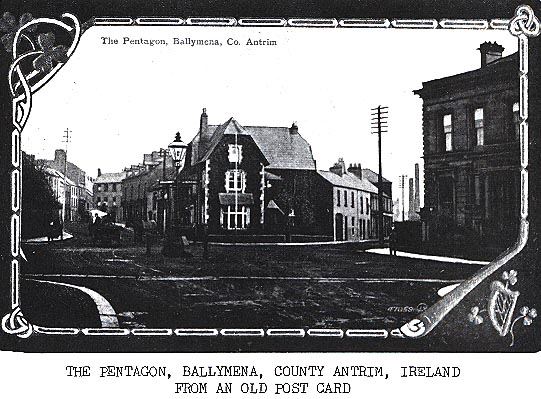|
 During the 1500's life in
Scotland had become increasingly hard and poor.
Tenants were being
dispossessed of their lands by greedy landlords.
They were now common laborers and town beggars.
By the early 1600's these Scots, who were mostly
Presbyterians and Covenanters, were so fed up
with poverty, lawlessness, insecurity and
religious turmoil, that they held meetings on
hillsides and carried arms to defend themselves.
Consequently during the next thirty years close
to forty thousand migrated to Northern Ireland. During the 1500's life in
Scotland had become increasingly hard and poor.
Tenants were being
dispossessed of their lands by greedy landlords.
They were now common laborers and town beggars.
By the early 1600's these Scots, who were mostly
Presbyterians and Covenanters, were so fed up
with poverty, lawlessness, insecurity and
religious turmoil, that they held meetings on
hillsides and carried arms to defend themselves.
Consequently during the next thirty years close
to forty thousand migrated to Northern Ireland.
In 1666, Rev. Adam Getty
crossed the North Channel from Scotland to
Ireland, and was ordained minister of the
Presbyterian Church in Ballymena. From 1659
through 1662 he had been a minister at Remeatt,
Scotland. Adam Getty was born in Dumbartonshire
deleted (accused) 26 July 1666 for living so
near to his former charge without license; fled
to Ireland 1665; installed Ballymena 1666. He
was minister of the First Ballymena Church from
1666 until his death in January 1675. It's
possible that Adam Getty was the forefather of
our Gettys, as well as of the forty other Getty
families who lived in County Antrim in the early
1800’s.
During the 1700's another
mass migration took place; from Northern Ireland
to America. The causes were mostly economic:
restrictions on woolen trade; restrictions on
manufacture of linen; and the ever present
excessive rents.
The final disaster was
several years of drought and the epidemic of
smallpox. Many Scotch Irish came to America as
indentured servants because they were unable to
pay their own passage. At the end of their
service, they would be free men, and were
usually given a small acreage, and some had
learned a trade.
 Most of these early
Scotch Irish immigrants were Presbyterians. They
may not have always been so pious and zealous,
but nevertheless the Presbyterian faith was
their proud heritage. These pioneers did
experience problems with their worship needs,
however, because of the lack of ministers, and
the great distance between churches in the back
countries. Most of these early
Scotch Irish immigrants were Presbyterians. They
may not have always been so pious and zealous,
but nevertheless the Presbyterian faith was
their proud heritage. These pioneers did
experience problems with their worship needs,
however, because of the lack of ministers, and
the great distance between churches in the back
countries.
In the early 1800's, the
residents of North Ireland continued to suffer,
for mostly political and economic reasons.
Between 1845 and 1847 their suffering came to a
bitter climax. The potato crop failed. Upon this
the poorer people depended almost entirely, and
a terrible famine resulted. Thousands died, and
hundreds of thousands emigrated. The Gettys were
more fortunate than most, because they were not
poor. Some of them were prosperous farmers, and
others worked in the linen mills.

Ireland was divided into
baronies which were divided into parishes. These
parishes were then divided into town lands which
were areas of varying sizes, sometimes less than
a square mile. The town lands of Dreen and
Craigs and the town of Cullybackey were all
situated in the parish of Craigs, which is
partly in the Barony of Kilconway and partly in
the Barony of Toome Lower, in County Antrim.
Cullybackey is three miles from Ballymena; it is
located on the River Maine. It contained, in the
early 1800's, about 50 houses, with 235
inhabitants. Dreen is about three miles from
Cullybackey, and Craigs Parish Church is only
about 11 miles from Cullybackey.
 This area, plus the
surrounding area stretching into the parishes of
Portglenone and Ahoghill, constituted for the
most part the homeland of our Gettys. The
rolling meadows had many lakes, rivers and
streams. Sheep and cattle grazed in the pastures
on the lush green hillsides. Unfortunately in
centuries past, large tracts of much of the best
land, where the soil was deep and rich were
parceled out in large estates owned by the
English and rented to Irish tenants. The soil
was soon over cultivated, and so became
exhausted. This contributed to the famines. This area, plus the
surrounding area stretching into the parishes of
Portglenone and Ahoghill, constituted for the
most part the homeland of our Gettys. The
rolling meadows had many lakes, rivers and
streams. Sheep and cattle grazed in the pastures
on the lush green hillsides. Unfortunately in
centuries past, large tracts of much of the best
land, where the soil was deep and rich were
parceled out in large estates owned by the
English and rented to Irish tenants. The soil
was soon over cultivated, and so became
exhausted. This contributed to the famines.
|